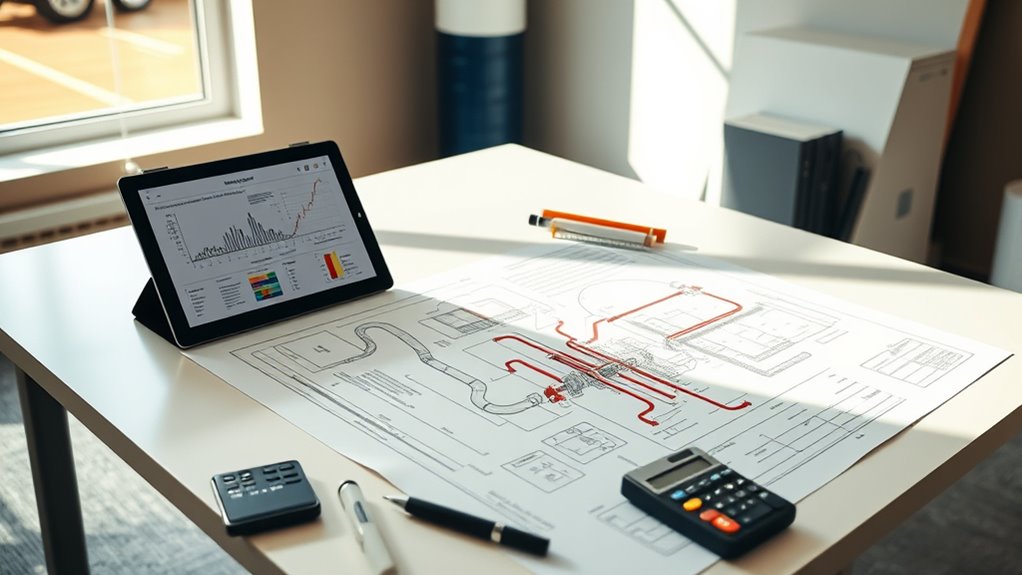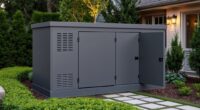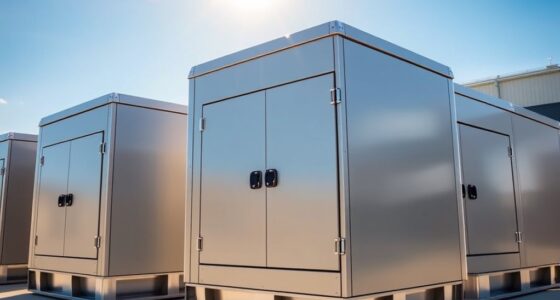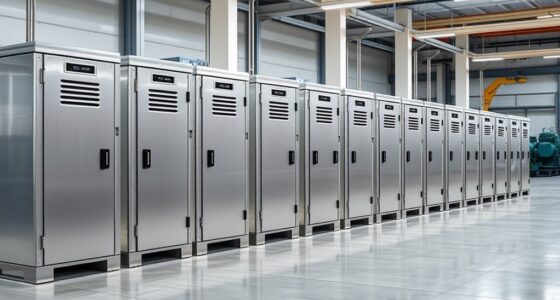Before starting your natural gas line installation, make certain you perform an advanced sizing checklist by calculating total demand, selecting appropriate pipe materials, and verifying compliance with local codes. Perform load calculations to determine flow capacities and choose pipe sizes that prevent pressure drops or oversizing. Plan your layout for efficiency and safety, ensuring ease of access and future expansion. Confirm all selections meet safety standards—keep these key steps in mind to build a reliable system. Continue to learn essential details for a safe and efficient setup.
Key Takeaways
- Verify total gas demand and flow requirements through comprehensive load calculations.
- Select appropriate pipe materials based on durability, flexibility, and compatibility with natural gas.
- Ensure compliance with local codes, standards, and installation regulations before starting.
- Plan pipe routing to minimize pressure loss, facilitate access, and accommodate future expansion.
- Double-check pipe sizes, material choices, and safety standards for accuracy and reliability.
Essential Checklist for Natural Gas Line Sizing
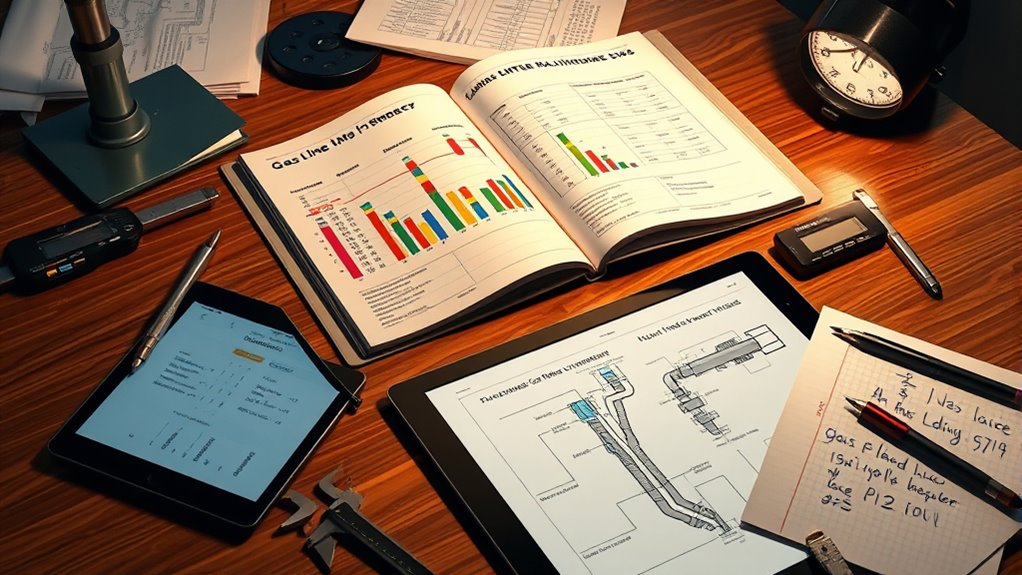
Properly sizing natural gas lines is essential for ensuring safe, efficient, and reliable fuel delivery. When you’re preparing to work on a gas line project, paying attention to details like gas flow optimization and pipe material selection can make all the difference. These factors directly influence how well your system performs, how safely it operates, and how long it lasts. Before you dive in to the installation or modification process, it’s crucial to follow a comprehensive checklist that covers all the necessary considerations.
First, you need to determine the total gas demand for your system. This involves calculating the BTU requirements of all appliances connected to the line. Accurate load calculation guarantees you select a pipe size that can handle the maximum flow without excessive pressure drops. Oversized pipes waste material and increase cost, while undersized pipes risk insufficient supply and unsafe conditions. Gas flow optimization comes into play here, helping you balance these factors for ideal performance.
Next, consider the pipe material selection carefully. Different materials—such as steel, copper, or polyethylene—offer distinct advantages and limitations. Your choice should be based on factors like durability, flexibility, corrosion resistance, and compatibility with natural gas. For example, steel pipes are strong and durable, but they may require special fittings and corrosion prevention measures. Polyethylene offers flexibility and ease of installation, especially for underground runs, but it may not be suitable for high-pressure applications. Proper pipe material selection ensures the system remains safe, reduces maintenance needs, and extends the lifespan of your gas line.
Another essential step involves reviewing local codes, standards, and regulations. These guidelines often specify minimum pipe sizes, allowable materials, and installation practices. Failing to adhere can lead to safety hazards or code violations, which might result in costly rework or legal issues. Always double-check that your planned setup complies with all relevant regulations.
Additionally, you should plan your layout carefully. Consider factors like pipe routing, accessibility for future inspections or repairs, and potential obstacles. Proper planning minimizes pressure losses and maximizes efficiency. When you’re sizing the line, remember to include allowances for future expansion or increased demand, if applicable.
Finally, before starting installation, double-check your calculations and selections, and ensure that all materials meet safety standards. Confirm that your pipe sizes align with the calculated flow rates and that your chosen materials are suitable for the specific conditions of your project. It is also beneficial to understand the impact of pipe material properties on long-term performance. By following this checklist, you set the foundation for a safe, efficient, and reliable natural gas system that performs ideally over time.
Frequently Asked Questions
How Do Local Codes Influence Gas Line Sizing Decisions?
Local codes play a crucial role in your gas line sizing decisions by ensuring code compliance and meeting permit requirements. You need to follow specific regulations that dictate pipe sizes, materials, and installation methods to prevent hazards. Ignoring these codes can result in fines or safety issues. Consequently, you must review local codes thoroughly, adapt your plans accordingly, and obtain all necessary permits before starting your gas line project.
What Safety Considerations Are Critical During Installation?
You must prioritize safety during installation by vigilantly monitoring for gas leaks and ensuring corrosion prevention. Use reliable gas leak detection methods to catch leaks early, preventing catastrophic failures. Protect the pipeline from corrosion with appropriate coatings and materials, extending its lifespan and avoiding dangerous leaks. Never rush the process—every step safeguards lives and property. Your careful attention to these safety measures can make the difference between a secure system and a disaster waiting to happen.
How Can I Identify Existing Gas Line Issues Before Sizing?
You can identify existing gas line issues by performing gas leak detection tests and corrosion assessments. Use a soapy water solution or electronic leak detectors to spot leaks, and inspect the pipe for rust, discoloration, or erosion. Address any leaks promptly, and evaluate corrosion levels to determine if the line needs repair or replacement before sizing. Regular inspections guarantee safe, efficient gas flow and prevent costly failures.
What Tools Are Best for Measuring Gas Flow Accurately?
Think of flow measurement tools as your gas line’s heartbeat monitor. A digital flow meter provides precise readings, while a differential pressure gauge helps you assess pressure drops during pressure testing. Both tools are essential for accurate flow measurement, revealing real-time data on gas volume and pressure. Using these tools guarantees you get reliable measurements, allowing you to size your natural gas line correctly and avoid potential issues down the line.
How Often Should Gas Lines Be Inspected and Maintained?
You should inspect and maintain your gas lines at least once a year to guarantee gas leak prevention and detect corrosion early. Regular checks help identify potential issues before they become dangerous. During inspections, look for corrosion, leaks, or damage, and perform maintenance as needed. Frequent inspections keep your system safe, extend its lifespan, and prevent costly repairs, giving you peace of mind knowing your gas lines are secure and well-maintained.
Conclusion
By following this checklist, you guarantee your natural gas line is perfectly sized, preventing potential hazards and inefficiencies. Think of it as laying a clear, steady path through a dense forest—each step must be precise to avoid pitfalls. When you prioritize accuracy and safety, your system functions smoothly, like a well-tuned engine. Remember, meticulous planning isn’t just a step; it’s the bridge to a safe, reliable gas supply that you can trust every day.
